- New Hampshire
- North Carolina
- Pennsylvania
- West Virginia
- Online hoaxes
- Coronavirus
- Health Care
- Immigration
- Environment
- Foreign Policy
- Kamala Harris
- Donald Trump
- Mitch McConnell
- Hakeem Jeffries
- Ron DeSantis
- Tucker Carlson
- Sean Hannity
- Rachel Maddow
- PolitiFact Videos
- 2024 Elections
- Mostly True
- Mostly False
- Pants on Fire
- Biden Promise Tracker
- Trump-O-Meter
- Latest Promises
- Our Process
- Who pays for PolitiFact?
- Advertise with Us
- Suggest a Fact-check
- Corrections and Updates
- Newsletters

Get PolitiFact in your inbox.
- Weekly Email Newsletter
- Daily Email Newsletter

- Reince Priebus

Were the 7 nations identified in Donald Trump's travel ban named by Barack Obama as terror hotbeds?
Two days after President Donald Trump temporarily banned certain groups of people from entering the United States, his chief of staff, Reince Priebus , defended the executive order by directing attention to terrorism and Trump’s predecessor, Barack Obama .
The protest-triggering order has been criticized as a "Muslim ban" ( it is and it isn’t, we found ). But Trump refutes that, asserting that the part of the order targeting seven Muslim-majority countries is aimed at fighting terrorism.
Priebus, a Wisconsin native, appeared Jan. 29, 2017 on NBC’s "Meet the Press" and said :
Here’s the deal: If you're coming in and out of one of those seven countries -- by the way, identified by the Obama administration as the seven most dangerous countries in the world in regard to harboring terrorists and affirmed by Congress multiple times -- then you're going to be subjected temporarily with more questioning until a better program is put in place over the next several months.
As we noted in our Muslim ban article, the large majority of jihadists committing acts of terror in America have been American citizens or legal residents.
And since 9/11, no one in the United States has been killed in a terrorist attack by someone from the seven countries, though there have been at least three non-deadly cases in which the perpetrator was connected to Iran or Somalia.
So, were the seven nations that are identified in Trump's travel ban pegged by the Obama administration as the "seven most dangerous countries in the world in regard to harboring terrorists"?
Not quite in that way, but Priebus has a point. Trump’s order
Trump’s executive order has two major components. It suspended entry of all refugees -- those who want to resettle in the United States -- for 120 days and barred refugees from Syria indefinitely. It also prohibits nearly all citizens from Iraq, Syria, Iran, Sudan, Libya, Somalia and Yemen from entering the United States for 90 days.
That travel part of the order is a Muslim ban in the sense that most residents of those seven countries are Muslim. But it’s not a ban, in the sense that the vast majority of Muslims in the world don’t live in those countries and thus are not affected by the order.
A week after the order, a federal judge issued a temporary restraining order, lifting the ban , although more court action followed.
The Obama connection
Featured Fact-check

The travel part of Trump’s order does target the same seven countries that were singled out with a law Obama signed in December 2015.
The Obama-signed law contains provisions that restrict travel to the United States for people who lived in or visited Iran, Iraq, Sudan, or Syria since March 2011. They must have a visa to enter the United States; they can’t use what is known as the Visa Waiver Program , which allows 90-day U.S. visits to other foreign visitors.
The law was soon expanded by Obama’s Department of Homeland Security to cover Libya, Somalia, and Yemen . They were identified in the agency’s announcement as "countries of concern," a phrase used in the law.
Daveed Gartenstein-Ross , a senior fellow at the Foundation for Defense of Democracies, told us Priebus’ claim is not misleading, but that the law Obama signed doesn’t define the seven countries as the most dangerous in terms of harboring terrorists. There are other countries where terrorists are active but could have been left off the Obama list for other reasons, he said.
There are countries, such as Pakistan, Afghanistan and others, where militants have significant space to operate, but there could be a variety of reasons why they were not included with countries where travel without visas is restricted by Obama law, he said. For instance, the U.S. government has a delicate relationship with the Pakistani government and there might be a desire on the part of the United States not to restrict travel from people in certain countries.
Two notes before we close that don’t directly bear on Priebus’ claim, but shed light on the seven countries:
Iran (added in 1984), Sudan (1993) and Syria (1979) are the only countries on the U.S. State Department’s list of "state sponsors of terrorism." They were determined by the secretary of state to have "repeatedly provided support for acts of international terrorism."
Iraq, Libya, Somalia and Yemen are on the State Department’s list of "terrorist safe havens" -- where terrorists operate "in relative security." But nine other countries or regions are on the safe havens list, too.
Priebus said Trump's executive order that temporarily bans nearly all travel to the United States from seven nations were "identified by the Obama administration as the seven most dangerous countries in the world in regard to harboring terrorists."
Prompted by concerns about terrorism, the Obama administration did put those seven countries -- Iraq, Syria, Iran, Sudan, Libya, Somalia and Yemen -- on a list that makes travel into the United States somewhat more difficult.
But that list doesn’t necessarily identify the seven as being the most dangerous.
For a statement is partially accurate but takes things out of context, our rating is Half True.

Read About Our Process
The Principles of the Truth-O-Meter
Our Sources
NBC, "Meet the Press" interview of Reince Priebus, Jan. 29, 2017
USA Today, "What you need to know about Trump's immigration plan," Jan. 28, 2017
Interview, Foundation for Defense of Democracies senior fellow Daveed Gartenstein-Ross , Feb. 3, 2017
The Atlantic, "What Trump's Executive Order on Immigration Does—and Doesn't Do," Jan. 30, 2017
U.S. State Department, "Visa Waiver Program," accessed Feb. 1, 2017
Email, George Mason University policy and government professor and Cato Institute senior fellow Trevor Thrall , Feb. 2, 2017
U.S. Department of Homeland Security, news release , Feb. 18, 2016
U.S. Department of Homeland Security, news release , Jan. 21, 2016
Email, New America International Security Program policy analyst David Sterman , Feb. 3, 2017
PolitiFact Wisconsin, "Is Donald Trump's executive order a 'Muslim ban'?" Feb. 3, 2017
U.S. State Department, "state sponsors of terrorism," accessed Feb. 3, 2017
U. S. State Department, " Country Reports on Terrorism 2015 -- Chapter 5: Terrorist Safe Havens"
PunditFact, "Glenn Beck says Barack Obama took Iran, Hamas off U.S. terror list," March 20, 2015
Browse the Truth-O-Meter
More by tom kertscher.

Were the 7 nations identified in Donald Trump's travel ban named by Barack Obama as terror hotbeds?

Support independent fact-checking. Become a member!
What do you think? Leave a respectful comment.

Joshua Barajas Joshua Barajas

Saher Khan Saher Khan
- Copy URL https://www.pbs.org/newshour/politics/key-moments-from-the-supreme-court-arguments-on-trumps-travel-ban
Key moments from the Supreme Court arguments on Trump’s travel ban
The Supreme Court heard arguments Wednesday over a version of President Donald Trump’s travel ban, which bars people from seven countries, five of them majority-Muslim, from entering the U.S.
This morning’s arguments marked the first time the high court has taken up a Trump administration policy — one that was widely criticized by opponents as a “Muslim ban” after it was first implemented shortly after Trump took office.
Lower courts blocked the two first iterations of the policy, which, citing security concerns over Islamic State militants, sought to prohibit travelers from Iran, Iraq, Libya, Somalia, Sudan, Syria and Yemen from coming into the U.S. (The second version of the ban took Iraq off the list, and the third version took off Sudan and added Chad, Venezuela and North Korea; the Trump administration took Chad off the current list this month.)
In December, the Supreme Court allowed the latest version of the Trump travel ban to continue while the justices worked through their review. During Wednesday’s arguments, the justices asked how much the president’s campaign comments — such as the promise of a “total and complete shutdown of Muslims entering the United States” — ought to be factored into a policy rollout like the travel ban once he was in office. Other justices appeared unwilling to undermine the president’s national security decisions.
Here are some major moments from Wednesday’s arguments in front of the court.
1. The hypothetical ‘out-of-the-box president’

Court sketch by Bill Hennessy
Justice Elena Kagan put forward a hypothetical to Solicitor General Noel Francisco, who defended the federal government: What if a future president, who was known as a “vehement anti-Semite” on the campaign trail, pushed forward policies that targeted Israel? Francisco responded by saying that this hypothetical leader would be allowed to implement such a policy despite any “animus.”
FRANCISCO: If his cabinet — and this is a very tough hypothetical that we’ve dealt with throughout — but if his cabinet were to actually come to him and say, Mr. President, there is honestly a national security risk here and you have to act, I think then that the President would be allowed to follow that advice even if in his private heart of hearts he also harbored animus. …
KAGAN: … This is a out-of-the-box kind of President in my hypothetical. (Laughter.) And — and, you know, he thinks that there are good diplomatic reasons, and there might — who knows what the future holds, that there might be good diplomatic reasons to put pressure on Israel or to say we want Israel to vote a certain way in the U.N. and this is a way to better our diplomatic hand, and so this is what he does. And — and who knows what his heart of hearts is. I mean, I take that point. But the question is not really what his heart of hearts is. The question is what are reasonable observers to think is making virulent anti-Semitic comments.
FRANCISCO: Right. And, Your Honor, it’s a tough hypothetical, but it’s why I also think that this is a relatively easy case, because we’re willing to even assume for the sake of argument that you consider all of the statements. And we’re even willing to assume for the sake of argument, though we think that it’s wrong, that you applied some kind of domestic establishment clause jurisprudence, because we’re quite confident that, given the process and substance that form the basis of this proclamation, no matter what standard you apply, this proclamation is constitutional. Since we don’t have the extreme hypothetical that you’re suggesting, Your Honor, we do have a multi-agency worldwide review and a Cabinet-level recommendation that applied a neutral baseline.
2. Justice Sonia Sotomayor has a lingering thought on this hypothetical president.

Solicitor General Noel Francisco before the Supreme Court justices. Court sketch by Bill Hennessy
Justice Sotomayor doubled down on the concerns of Kagan’s hypothetical president’s campaign behavior, asking if the president’s Cabinet was subject to “thorough review” if they were ordered to carry out a potentially anti-Semitic policy. Francisco said the Cabinet is sworn to uphold the Constitution and its merits.
SOTOMAYOR: General, today, can we go back to something that’s been bothering me here, which is … that the President is the head of the executive branch and that he should have, for those who are in the extreme of this theory or — or on one end of the theory — not extreme, that he can hire or fire anyone he wants and that he can put in place whatever policy he wants. If we take Justice Kagan’s hypothetical president, who basically says to his review committee, ‘I want to keep out Jews — period; find a way.’ That’s their charge. So, in that situation, why would the actions of the committee, whatever this is, Executive Committee, not be subject to great suspicion and to thorough review …, given that they are responsible to the executive, and they’ve been told what the outcome of their deliberations must be?
FRANCISCO: … the President’s Cabinet, just like all of us here, is duty-bound to protect and defend the Constitution. So I would expect that if any Cabinet member were given that order, that Cabinet member would refuse to comply or resign in the face of a plainly unconstitutional order. … you have the Cabinet doing its job through the agencies, where they ask the agencies to construct and apply this neutral standard to every country in the world, including every Muslim country. They concluded that the vast majority of the world, including the vast majority of the Muslim world, was just fine, but there were problems with a small number of countries and so imposed pressure, recommended pressure, to help move those countries across the line.
3. Is the travel ban truly a “perpetual problem”?

Attorney Neal Katya before the Supreme Court justices. Court sketch by Bill Hennessy
Attorney Neal Katyal, representing the state of Hawaii in the case, had an important back-and-forth exchange with Justice Anthony Kennedy, a conservative justice who has been the swing vote in major rulings in recent years, over the assertion that the travel ban was a “perpetual problem.” Kennedy, in response, asked if a president could reasonably say there could be a “safe world” in 180 days.
ALITO: What is your basis for saying that [the travel ban] is perpetual?
KATYAL: Well, there’s nothing in the order that ends it. And you heard my friend say, “Oh, that would doom all executive orders.” But that’s not true. Half of these —
KENNEDY: I thought it had to be reexamined every 180 days?
KATYAL: No, that’s not what it says. It says there’s a report that has to come in at 180 days, and nothing happens at the end of the report.
KENNEDY: Well, that — that indicates there will be a reassessment? … And then the President has continuing discretion?
KATYAL: Justice Kennedy, this argument wouldn’t be there if there was anything about reassessment, the way there are in about half the orders, including the Cuba order, which says it sunsets once the crisis ends. There’s nothing like that in this. And it’s just like a reporting requirement to Congress in which Congress isn’t necessarily required to do anything. Congress has statutes like that all the time. This is that. And that’s why this is unlike any other executive order. If you go back and look at all 43 executive orders that Presidents have issued, none of them have even arguably countermanded Congress’s judgment in the area. They’ve all been consistent. They’ve all been supplements.
KENNEDY: Well, the statute says first that 1182 for such period as he deems necessary, and he can have continuing supervision over whether it’s still necessary.
KATYAL: Again, we wouldn’t have a problem with that if it was tailored to a crisis, it says it sunsets, and then, you know, could be re-upped or something like that. That’s not what this says. This is about a perpetual problem.
KENNEDY: So you want the President to say, I’m convinced that in six months we’re going to have a safe world?
KATYAL: Well — well — well, no, Justice Kennedy, that’s not our argument. Our argument is, here, the President is identifying something that is a perennial problem. Our brief says it goes back 100 years, you know, when the Soviet Union was around, we don’t have countries that cooperate with us in vetting. And the solution has always been from Congress not to have a flat ban, but instead to have a fine-grained vetting system to balance these considerations.
4. The executive branch’s ability to make national security decisions
Chief Justice John Roberts, in his questioning, wondered if a president would be too restricted from enacting national security measures if the office was prevented from targeting specific countries. Roberts specifically asked what would happen if the vetting procedures weren’t “taken seriously” under new leadership.
ROBERTS: What about - what about a change of administration in a particular country, in which perhaps the vetting procedures are not going to be taken seriously? That Congress could not have anticipated?
KATYAL: Well, but, again, Congress anticipated a country that is a “state sponsor of terrorism” and even for — with respect to that, providing no information and indeed fomenting against the United States, Congress said, “Oh, we’re not going to have a nationality ban.” You know, they flatly banned that and said we’re going to have individualized vetting and this Visa Waiver Program carrot to try and deal with that, you know, dangerous regime. Now, again, I can imagine an emergency situation in which the President would have even greater authority for that, but, here, we are 460 days later and I would caution the Court not to make a decision about the emergency you’re concerned about. That can be bracketed as it was in Youngstown, as it was in Hamdan. This is so far from that. The text of 1152 is flatly violated here. It says there shall be no discrimination on the basis of nationality with the issuance of visas. That is 39 percent of all the visas this executive order covers. It’s not a small part. It’s a large part. And it is the most important part because immigrant visas are the kind of heart about, you know, what the nation becomes. It’s people who want to come here and become part of our long-term polity. This executive order flatly contradicts that. Now, if you accept his interpretation — he says, well, you know, we’re discriminating at the entry side, not at the visa side. If you do that, you are giving the President the power to undo — and he’s actually just done it — he’s undone the ban on nationality-based discrimination. He’s imposed country quotas of zero for these countries at the border.
5. Is it a “Muslim ban”?
Justice Samuel Alito openly asked Katyal if a closer look at the justifications for the travel ban led someone to believe that the Trump policy was a “Muslim ban.” Katyal answered yes, but Alito later flatly said, “it does not look at all like a Muslim ban.”
ALITO: Mr. Katyal, would any reasonable observer reading this proclamation, with — without taking into account statements, think that this was a Muslim ban? I mean, there are — I think there are 50 predominantly Muslim countries in the world. Five — five countries — five predominantly Muslim countries are on this list. The population of the — of the predominantly Muslim countries on this list make up about 8 percent of the world’s Muslim population.
KATYAL: Absolutely …
ALITO: If you looked at the 10 countries with the most Muslims, exactly one — Iran — would be on that list of the top 10. So would a reasonable observer think this was a Muslim ban?
KATYAL: If it were just the text of the order alone, it might raise eyebrows, for fit and other reasons that the briefs go into, but we wouldn’t be here. We absolutely agree that just — it’s the same test as in Lukumi and other cases. You have to look to all the circumstances around it that are said, the publicly available ones. You know, and, Justice Alito, the fact that the order only come — encompasses some Muslim countries I don’t think means it’s not religious discrimination. For example, if I’m an employer and I have 10 African-Americans working for me and I only fire two of them, I don’t think — you know, and say, well, I’ve left the other eight in, I don’t think anyone can say that’s not discrimination.
ALITO: No, I — I understand that. And it is one of our fundamental values that there is religious freedom here for everybody in that, number — adherence to every religion are entitled to equal treatment. My only point is that if you look at what was done, it does not look at all like a Muslim ban. There are other justifications that jump out as to why these particular countries were put on — on the list.
Analysis: The constitutional showdown over President Donald Trump’s travel ban
Joshua Barajas is a senior editor for the PBS NewsHour's Communities Initiative. He also the senior editor and manager of newsletters.
Saher Khan is a reporter-producer for the PBS NewsHour.
Support Provided By: Learn more
Educate your inbox
Subscribe to Here’s the Deal, our politics newsletter for analysis you won’t find anywhere else.
Thank you. Please check your inbox to confirm.

How Trump’s travel ban changed and what comes next
World Sep 25
Take Our Quiz »
Find the best country for you: », places the u.s. government warns not to travel right now.
You may want to reconsider traveling to these countries right now.

Do Not Travel to These Countries

Getty Images
Crime, civil unrest and terrorism are common risk factors for countries that end up on the State Department's "Do Not Travel" advisory list.
In 2024, tourism across the globe is “well on track” to return to pre-pandemic levels, according to projections by UN Tourism.
Global conflicts and natural disasters , ranging from a series of coups across Africa to catastrophic earthquakes in the Middle East affected international travel patterns throughout 2023. Still, international tourist arrivals reached 87% of pre-pandemic levels in 2023, according to estimates by UN Tourism .
In January 2024 alone, about 4.6 million U.S. citizens left the country for international destinations, 17% higher than the same month in 2019, according to the International Trade Administration . But some destinations warrant more caution than others.
On Oct. 19, 2023, following the outbreak of war between Israel and Gaza and flaring tensions in the region, the U.S. State Department issued a worldwide caution advisory due to “increased tensions in various locations around the world, the potential for terrorist attacks, demonstrations or violent actions against U.S. citizens and interests.” Prior to this update, the most recent worldwide caution advisory was issued in 2022 after a U.S. strike killed Ayman al-Zawahiri, Osama bin Laden’s successor as leader of Al Qaeda, causing “a higher potential for anti-American violence.” The worldwide caution advisory remains in effect.
The U.S. State Department also issues individual travel advisory levels for more than 200 countries globally, continually updating them based on a variety of risk indicators such as health, terrorism and civil unrest. Travel advisory levels range from Level 1, which means exercise normal precautions, to Level 4, which means do not travel there.
About 10% of countries – 19 total – have a Level 4: “Do Not Travel” advisory as of Mar. 4. In Level 4 countries, the U.S. government may have “very limited ability” to step in should travelers’ safety or security be at risk, according to the State Department. Crime, civil unrest, kidnapping and terrorism are common risk factors associated with Level 4 countries.
So far in 2024, the State Department made changes to the existing Level 4 advisories for Myanmar, Iran and Gaza, and moved Niger and Lebanon off of the Level 4 list.
Places With a Level 4 Travel Advisory
These are the primary areas the U.S. government says not to travel to right now, in alphabetical order:
Jump to Place: Afghanistan Belarus Burkina Faso Central African Republic Myanmar (formerly Burma) Gaza Haiti Iran Iraq Libya Mali Mexico North Korea (Democratic People's Republic of Korea) Russia Somalia South Sudan Sudan Syria Ukraine Venezuela Yemen
Afghanistan: The Central Asian country is wrestling with “terrorism, risk of wrongful detention, kidnapping and crime,” according to the State Department. U.S. citizens are specifically at risk for wrongful detention and kidnapping. In 2022, the government reinstituted public floggings and executions, and women’s rights are disappearing under Taliban control. The U.S. Embassy in Kabul halted operations in August 2021. Since the Taliban took control , many forms of international aid have been halted . Meanwhile, in 2023, some of the year’s deadliest earthquakes killed more than 2,400 in Afghanistan while the country continues to face a years-long extreme drought.
Belarus: Belarus, which shares a western border with Russia and a southern border with Ukraine, has been flagged for “Belarusian authorities’ continued facilitation of Russia’s war against Ukraine, the buildup of Russian military forces in Belarus, the arbitrary enforcement of local laws, the potential of civil unrest, the risk of detention, and the Embassy’s limited ability to assist U.S. citizens residing in or traveling to Belarus.” The U.S. Embassy in Minsk halted operations in February 2022.
Burkina Faso: Terrorism, crime and kidnapping are plaguing this West African nation. Terrorist attacks may target hotels, restaurants and schools with little to no warning, and the East and Sahel regions of the country are under a state of emergency. In late November 2023, hundreds died in clashes between state security forces and rebels near the country’s border with Mali. In June, more than 2 million people in Burkina Faso were displaced due to “violence linked to al-Qaida and the Islamic State group.”
Central African Republic: While there have not been specific incidents of U.S. citizens targeted with violence or crime, violent crime and sudden closure of roads and borders is common. The advisory states that “Embassy Bangui’s limited capacity to provide support to U.S. citizens, crime, civil unrest, and kidnapping” is a factor in its assessment. Recent data from UNICEF suggests the country has the worst drinking water accessibility of all countries in 2022.
Myanmar (Formerly Burma): Armed conflict and civil unrest are the primary reasons to not travel to this Southeast Asian country, which experienced a military coup in early 2021. Limited health care resources, wrongful detentions and “areas with land mines and unexploded ordnance” are also listed as risk factors. After Ukraine and Israel, Myanmar had the highest conflict-related death toll in 2023.
Gaza : Hamas, a foreign terrorist organization as designated by the State Department, controls much of the Gaza Strip, which shares borders with both Israel and Egypt. On Oct. 7, 2023, Hamas fighters broke across the border into Israel, killing hundreds of civilians and soldiers in a brazen attack that stunned Israelis. On Oct. 10, Israel hit the Gaza Strip with “the fiercest air strikes in its 75-year conflict” according to Reuters . The conflict has since escalated into war between Israel and Hamas, with regular Israeli airstrikes leading to extensive civilian casualties in Gaza. As of mid-December, nearly 85% of Gaza’s population were displaced from their homes, according to UN estimates . The region continues to face shortages of food , water, electricity and medical supplies , with conditions deemed “far beyond a humanitarian crisis.” The State Department warns of terrorism and armed conflict within Gaza’s borders.
Haiti: In July 2023, the Department of State ordered all non-emergency U.S. government personnel and family members to leave the U.S. Embassy in Port-au-Prince in response to the increased risk of kidnapping and violent crime in the country , as well as armed conflict between gangs and police. The travel advisory states that cases of kidnapping “often involve ransom negotiations and U.S. citizen victims have been physically harmed during kidnappings.” The travel advisory also states that “U.S. citizens in Haiti should depart Haiti as soon as possible” given “the current security situation and infrastructure challenges.” A series of gang attacks in late September 2023 caused thousands to flee their homes, and many aid groups have been forced to cut or suspend operations amid escalating violence in recent months.
Iran: Terrorism, kidnapping and civil unrest are risk factors for all travelers to Iran, while U.S. citizens are specifically at risk for “arbitrary arrest.” U.S.-Iranian nationals such as students, journalists and business travelers have been arrested on charges of espionage and threatening national security. Executions in Iran rose sharply between 2021 and 2022, bringing the country’s total to nearly 580 people over the year, according to a report by Amnesty International released in May 2023.
Iraq: The State Department cites “terrorism, kidnapping, armed conflict [and] civil unrest” as cause for the country’s Level 4 distinction. Iraq’s northern borders, and its border with Syria, are especially dangerous. Since the escalation of conflict in neighboring Israel in October, there has been an increase in attacks against Iraqi military bases, which host U.S. troops and other international forces. In October 2023, non-emergency U.S. government personnel and eligible family members were ordered to leave the U.S. embassy in Baghdad.
Libya: Following the end of its dictatorship over a decade ago, Libya has been wrought with internal conflict between armed groups in the East and West. Armed conflict, civil unrest, crime, kidnapping and terrorism are all risk factors. U.S. citizens have been targets of kidnapping for ransom, with terrorists targeting hotels and airports frequented by Westerners. The U.S. Embassy in Tripoli halted operations in 2014. In mid-September 2023, floods, which some say were intensified by climate change , killed thousands in eastern Libya. Clashes between armed factions escalated across the country in the latter half of 2023, including in the capital city of Tripoli and in Benghazi.
Mali: After experiencing military coups in 2020 and 2021, crime, terrorism and kidnapping are all prevalent threats in this West African landlocked nation. In July 2022, non-emergency U.S. government employees and their families were ordered to leave the country due to higher risk of terrorist activity. A U.N. report in August 2023 said that military groups in the country, including both Mali security forces and possibly Russian Wagner mercenaries, were spreading terror through the use of violence against women and human rights abuses. Democratic elections were supposed to occur in February 2024, but Mali’s military junta postponed the plans indefinitely. In December, the U.N. officially ended a decade-long peacekeeping presence in the country, which had been among the agency’s deadliest missions, with hundreds of the mission personnel killed since 2013.
Mexico: Each state in Mexico is assessed separately for travel advisory levels. Six of the 32 states in Mexico are designated as Level 4: Colima, Guerrero, Michoacan, Sinaloa, Tamaulipas and Zacatecas. Crime and kidnapping are listed as the primary risk factors throughout the country. Nearly 112,000 people were missing across the country as of October, a number the U.N. has called “alarming.”
North Korea (Democratic People’s Republic of Korea): U.S. passports are not valid for travel “to, in, or through” this country, home to one of the world's longest-running dynastic dictatorships. The travel advisory states that the Level 4 distinction is due to “the continuing serious risk of arrest and long-term detention of U.S. nationals.” In July 2023, a U.S. soldier fled across the border into North Korea, where he is believed to be in North Korean custody, the first American detained in the North in nearly five years. He was returned to U.S. custody in September 2023.
Russia: The travel advisory for Russia cites its invasion of Ukraine , harassment of U.S. citizens by Russian government officials and arbitrary law enforcement as a few of the reasons for the Level 4 designation. Chechnya and Mount Elbrus are specifically listed as Level 4 regions. Terrorism, civil unrest, health, kidnapping and wrongful detention are all noted as risks.
Russia Invades Ukraine: A Timeline

Somalia: A severe drought resulting from five failed rainy seasons in a row killed 43,000 people in 2022, and caused a famine amid conflict with Islamist insurgents . Violent crime is common throughout Somalia , pirates frequent its coast off the Horn of Africa, and medical facilities, where they exist, have limited capacity. Crime, terrorism, civil unrest, health and kidnapping are all risk factors. In January 2024, some passengers aboard a U.N.-contracted helicopter were taken hostage by al-Shabaab militants after the vehicle crashed in central Somalia.
South Sudan: Crime, kidnapping and armed conflict are the primary risk factors for South Sudan, which separated from Sudan in 2011, making it the world’s newest country . Weapons are readily available, and travelers have been victims of sexual assault and armed robbery.
Sudan: The U.S. evacuated its embassy in Khartoum in April 2023, and the country closed its airspace due to the ongoing conflict in the country, only permitting humanitarian aid and evacuation efforts. Fighting has escalated in the region between two warring generals seeking to gain control after a military coup in 2021 ousted the country’s prime minister. Civil unrest is the primary risk factor for Africa’s third largest country by area. Crime, terrorism, kidnapping and armed conflict are also noted. The International Criminal Court began investigating alleged war crimes and violence against African ethnic groups in the country in 2023. Millions have fled their homes due to conflict, and the U.N. has said its efforts to provide aid have been hindered by a lack of support, safety and resources. As recently as December 2023, the United Nations warned of catastrophic famine , with millions of children at-risk for malnutrition .
Syria: The advisory states that “No part of Syria is safe from violence,” with terrorism, civil unrest, kidnapping, armed conflict and risk of unjust detention all potential risk factors. U.S. citizens are often a target for kidnappings and detention. The U.S. Embassy in Damascus halted operations in 2012. Fighting in neighboring Israel has escalated since October, and the conflict has spilled over into Syria, where the U.S. has carried out air strikes following drone and rocket attacks against American troops in Syria and Iraq, triggered by the Israel-Hamas war.
Ukraine: Russian setbacks in their invasion of Ukraine buoyed hopes in Ukraine in 2023. However, Ukraine is a Level 4 country due to Russia’s invasion, with crime and civil unrest also noted as risk factors. The country’s forces shot down two Russian fighter jets on Christmas Eve 2023, in a move Ukrainian President Volodymyr Zelenskyy said “sets the right mood for the entire year ahead.”
Venezuela: Human rights abuses and lack of health care plague this South American nation, which has been in a political crisis since 2014. In 2019, diplomatic personnel were withdrawn from the U.S. Embassy in Caracas. Threats in the country include crime, civil unrest, kidnapping, wrongful detention and poor health infrastructure.
Yemen: Six of the nine risk factors defined by the State Department – terrorism, civil unrest, health risks, kidnapping, armed conflict and landmines – are all present in Yemen. Despite private companies offering tourist visits to the Yemeni island of Socotra, the U.S. government argues those arranging such visits “are putting tourists in danger.” Civil war and cholera are also both present throughout the country. The U.S. Embassy in Sanaa halted operations in 2015. The country has experienced a relative lull in the civil war fighting, but as peace negotiations have gotten traction, flare ups in the fighting have jeopardized progress. Most recently, the U.S. and U.K. have carried out a series of airstrikes in the country, targeting Iran-backed Houthi sites.
Other Countries to Watch
Since Jan. 1, the State Department has updated travel advisories for 17 different countries as well as for the West Bank and Gaza, adding information about specific regions or risk factors, or simply renewing an existing advisory. Travel advisory levels can change based on several factors in a nation, such as increased civil unrest, policies that affect human rights or higher risks of unlawful detention.
The State Department has given about 25 countries an assessment of Level 3, meaning it recommends people “reconsider travel” to those destinations.
On Oct. 14, one week after the deadly Hamas attack on Israel, Israel and the West Bank were both moved from Level 2 to Level 3, while Gaza remains at Level 4. The region’s travel advisory was updated in November to reflect travel restrictions for certain government employees who have not already left the area, and it was updated again on Jan. 3.
Following the outbreak of the Israel-Hamas war in early October, the U.S. State Department raised Lebanon ’s travel advisory level from a Level 3 to a Level 4 level due to “the unpredictable security situation related to rocket, missile, and artillery exchanges” between Israel and Hezbollah or other militant groups. In December, the U.S. Embassy in Beirut returned to normal staffing and presence, and on Jan. 29, the country was moved back to Level 3. Crime, terrorism, armed conflict, civil unrest, kidnapping and unexploded landmines are listed as the country’s primary risk factors. However, the country’s borders with Syria and with Israel, as well as refugee settlements within Lebanon, are specifically noted as Level 4 regions.
China became a Level 3 country in late 2020, with an update in December 2022 citing “the surge in COVID-19 cases, arbitrary enforcement of local laws, and COVID-19-related restrictions” as the reason for the advisory. In June 2023, the Hong Kong Special Administrative Region (SAR) was moved from the Level 3 to the Level 2 list, but travelers are still advised to be cautious in the area due to “arbitrary enforcement of local laws.” Meanwhile, Macau remains at Level 3.
Following an attempted coup in August 2023, Niger was elevated to Level 4 in August and the Department of State ordered all non-emergency U.S. government personnel and family members to leave the U.S. Embassy in Niamey. In early January 2024, the overall risk level for the country was lowered back to Level 3. Despite the new classification, the State Department still asks non-emergency government personnel and eligible family members to depart the country.
In mid-December 2023 there was an explosion at Guinea’s main fuel depot which has since affected access to health care and basic goods and services. The country was subsequently designated a Level 3 nation after having previously been Level 2. Concerns about civil unrest, health, crime and fuel shortages impacting local infrastructure were listed as the primary risk factors contributing to the change.
Several Level 3 countries are among the worst countries for human trafficking, as designated by the State Department’s annual Trafficking in Persons Report . Level 3 countries on this list include Papua New Guinea, Guinea Bissau, China and Chad. There are also nine Level 4 countries designated as among the worst for human trafficking: Afghanistan, Belarus, Iran, Myanmar, North Korea, Russia, Syria, South Sudan and Venezuela.
Over 70 countries are currently at Level 2, meaning the State Department recommends travelers “exercise increased caution” when traveling to those destinations.
Botswana became the newest Level 2 country on Feb. 26 after having previously been Level 1, with crime noted as the primary risk factor.
France, which saw nationwide protests throughout 2023, has civil unrest and terrorism noted as risk factors for its Level 2 status, and Sweden’s Level 2 status is associated with risks of terrorism.
The Level 2 travel advisory for the Bahamas was updated in January to reflect water safety concerns. The advisory warns that “activities involving commercial recreational watercraft, including water tours, are not consistently regulated” and notes that government personnel are “not permitted to use independently operated jet-ski rentals on New Providence and Paradise Islands.” It also warns visitors to be mindful of sharks, weather and water conditions. The advisory also says that crime is a primary risk factor with gang-on-gang violence contributing to high homicide rates in some areas. Visitors are asked to “be vigilant” and to not physically resist robbery attempts.
Bangladesh 's Level 2 travel advisory was updated in October 2023 to add a note about the country’s general election , which took place Jan. 7, 2024. The advisory states “demonstrations intended to be peaceful can turn confrontational and escalate into violence.” The U.S. has since claimed the country’s election was not free nor fair.
In November 2023, several Level 2 travel advisories were updated with new cautionary information. The advisory for Ghana was updated to reflect threats against LGBTQI+ travelers specifically, noting “anti-LGBTQI+ rhetoric and violence have increased in recent years.” Meanwhile, the advisory for South Africa was updated in February to note that routes recommended by GPS may be unsafe with higher risk for crime.
Turkmenistan was moved off of the Level 2 list to become the newest addition to the Level 1 list on Jan. 22, meaning normal precautions are recommended but there are no risk factors causing travelers to practice increased caution.
The State Department asks travelers to pay attention to travel advisory levels and alerts , review country information pages for their destinations and read related country security reports before going abroad.
Join the Conversation
Tags: Russia , Ukraine , Travel , Coronavirus , Travel Tips , Israel , Gaza , violence , Civil War , crime , kidnapping , international relations
Recent Articles
Best countries.

U.S. News Decision Points

Best Countries Rankings
- # 1 Switzerland
- # 3 United States
- # 5 Australia
Your trusted source for the latest news delivered weekdays from the team at U.S. News and World Report.
Sign in to manage your newsletters »
Sign up to receive the latest updates from U.S News & World Report and our trusted partners and sponsors. By clicking submit, you are agreeing to our Terms and Conditions & Privacy Policy .
You May Also Like
Switzerland is the best country for 2024.
Julia Haines Sept. 10, 2024

Photos: Best Countries Around the World
Sept. 10, 2024

The 25 Best Countries in the World
Elliott Davis Jr. Sept. 10, 2024

U.S. Rises in Best Countries Rankings

Soccer-Trial Over Maradona's Death Postponed Until 2025
Reuters Sept. 12, 2024

- Travel Advisories |
- Contact Us |
- MyTravelGov |

Find U.S. Embassies & Consulates
Travel.state.gov, congressional liaison, special issuance agency, u.s. passports, international travel, intercountry adoption, international parental child abduction, records and authentications, popular links, travel advisories, mytravelgov, stay connected, legal resources, legal information, info for u.s. law enforcement, replace or certify documents.
Share this page:
Learn about your destination
Take 90 seconds for safer travel.
Travel Advisory Levels
Enroll in step.

Subscribe to get up-to-date safety and security information and help us reach you in an emergency abroad.
Recommended Web Browsers: Microsoft Edge or Google Chrome.
External Link
You are about to leave travel.state.gov for an external website that is not maintained by the U.S. Department of State.
Links to external websites are provided as a convenience and should not be construed as an endorsement by the U.S. Department of State of the views or products contained therein. If you wish to remain on travel.state.gov, click the "cancel" message.
You are about to visit:
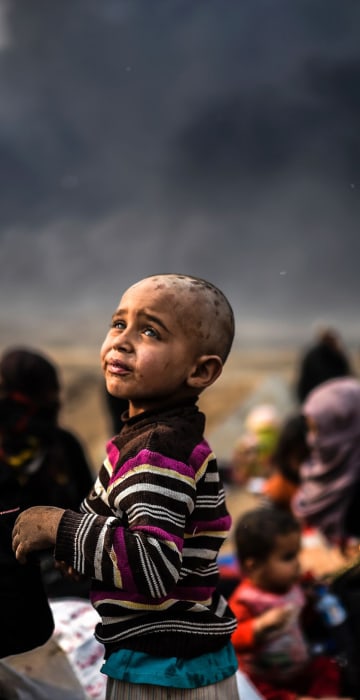
Life on the Ground in the 7 Travel Ban Countries
The everyday conflicts and difficulties faced by the people living in the seven countries subject to President Trump's travel ban.
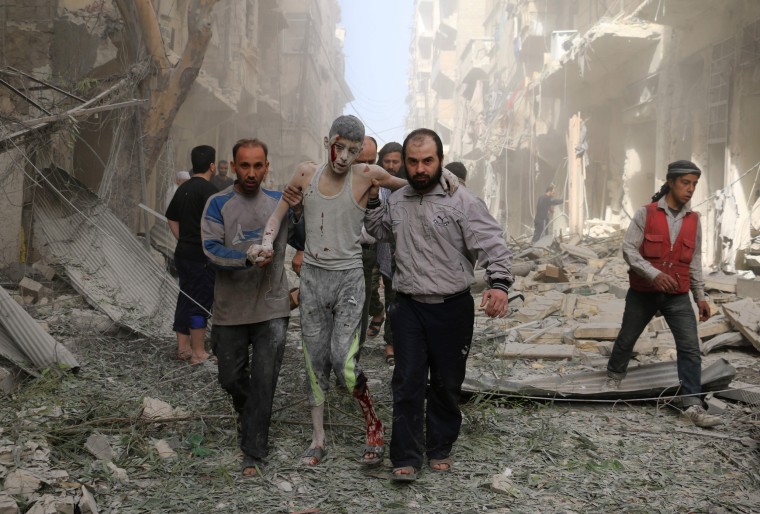
On Friday Jan. 27, citing terrorism concerns, President Trump issued an executive order that temporarily restricts entry to the U.S. from seven Muslim-majority countries. .
The United Nations has said 250,000 people have died in the conflict that grew out of protests against the rule of President Bashar al-Assad in 2011. Assad now holds the upper hand in the Syrian war, bolstered by allies Russia and Iran whose military involvement has turned the conflict to his advantage.
Above: A wounded youth is aided following an air strike on a rebel-held neighborhood of Aleppo on Apr. 26, 2016.
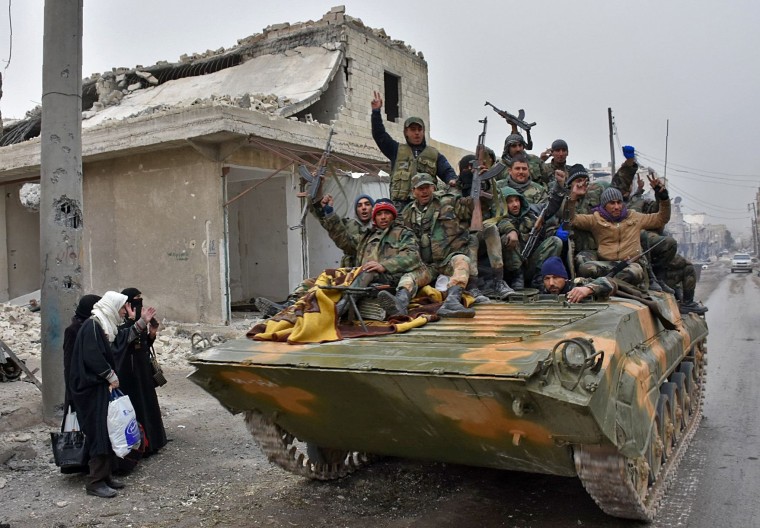
Syrian pro-government forces drive past residents fleeing eastern Aleppo on Nov. 30.
At the end of 2016, rebel groups were driven from areas they held for years in east Aleppo, their last major urban stronghold, causing a mass exodus of terrified civilians.
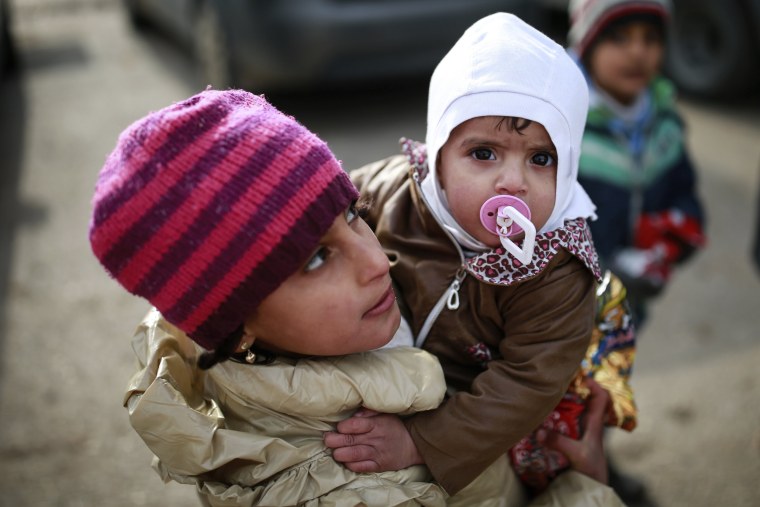
Syrian children wait for other members of their family after they crossed into Turkey near Hatay on Dec. 17, 2016.

Civilians have been fleeing Mosul in massive numbers as American-backed forces in Iraq have been battling for more than three months to recapture the ISIS stronghold. Humanitarian groups have warned that there are still hundreds of thousands of people in the besieged area facing severe food, water, fuel and medical shortages.
Above: Families displaced by the ongoing operation by Iraqi forces against ISIS in Mosul, gather in an area near Qayyarah on Oct. 24, 2016.
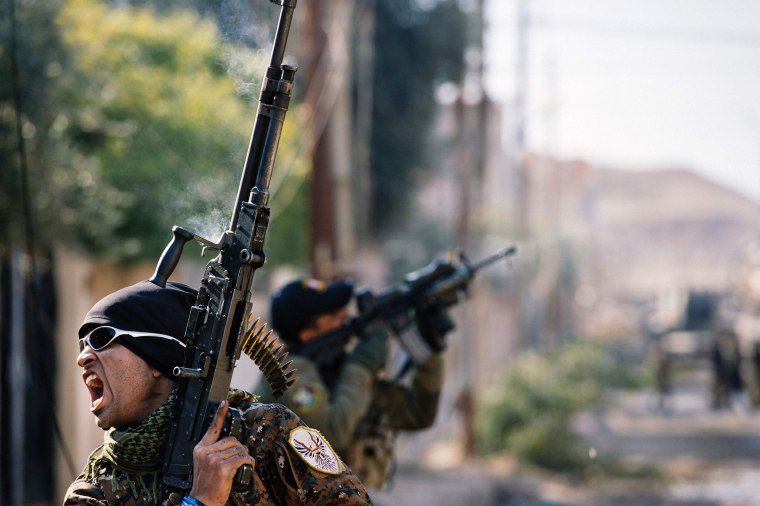
An Iraqi special forces soldier screams during a battle against ISIS fighters in Mosul's al-Rifaq neighborhood on Jan. 8, 2017.
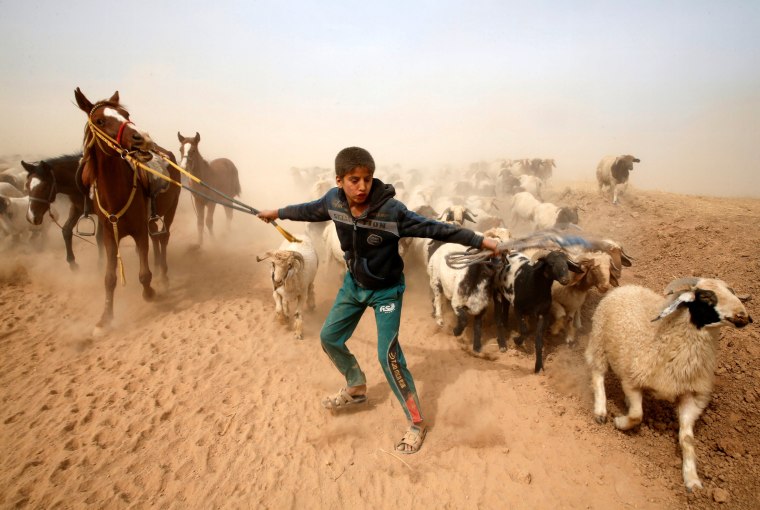
A displaced Iraqi boy leads his animals to safety after escaping from the ISIS-controlled village of Abu Jarboa, near Mosul, on Nov. 1, 2016.
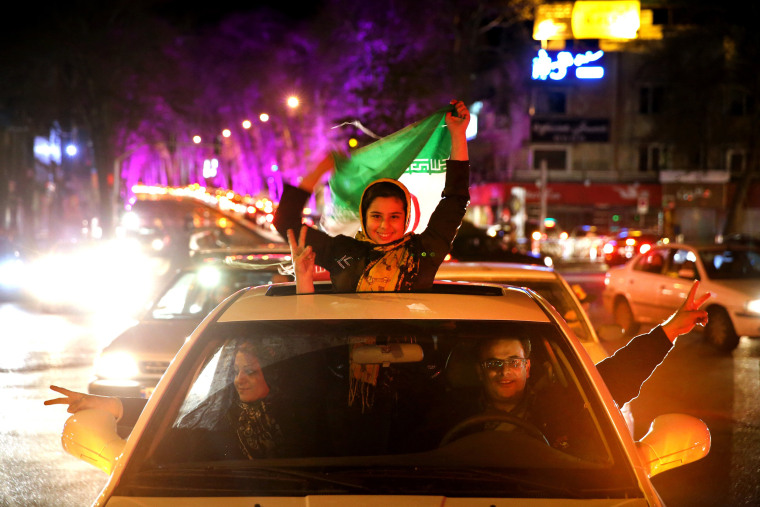
In 2015, Iran reached a landmark deal with six world powers aiming at curbing Iran's nuclear activities in exchange for easing international sanctions. Donald Trump has called the deal "catastrophic" and vowed to scrap it.
Above: Iranians celebrate after Iran's nuclear agreement with world powers was announced, in northern Tehran on Apr. 2, 2015.
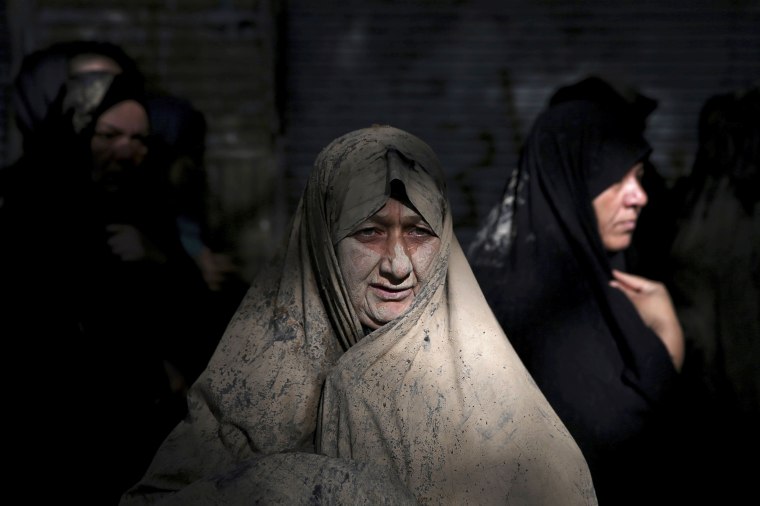
An Iranian Shiite Muslim mourns after covering herself with mud during Ashoura rituals at the city of Khorramabad on Oct. 12, 2016.
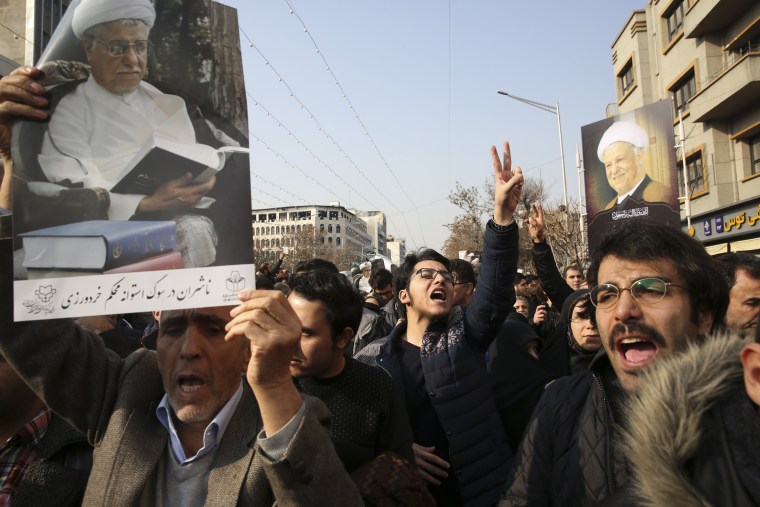
Mourners chant slogans while flashing the victory sign, referring to the success of moderates and reformists in recent elections, during the funeral of former Iranian President Akbar Hashemi Rafsanjani, in Tehran on Jan. 10, 2017.
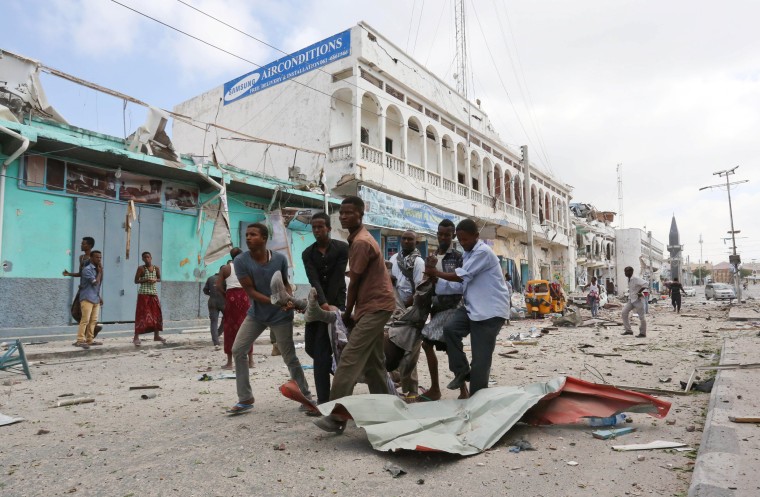
The al-Shabab extremist group, Al-Qaida's East African affiliate, is fighting to impose a strict version of Islam in Somalia, lashing out with deadly attacks like the assault on a hotel in the capital, Mogadishu, on Jan. 25, that killed at least 26.
Thousands of African Union troops are in Somalia to bolster the country's weak government.
Above: Rescuers carry an injured man from the scene of an explosion in front of Dayah hotel in Somalia's capital Mogadishu on Jan. 25, 2017.
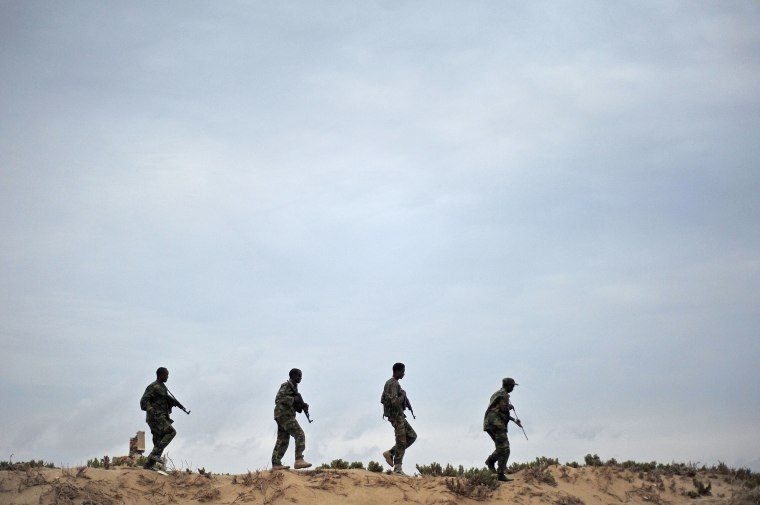
Security forces patrol along the coast of Qaw, in Puntland on Dec. 18, 2016.
Armed militants groups have become more active in the Puntland's region, northern Somalia, since being pushed out of their strongholds in southern Somalia by African Union forces and the Somali National Army.
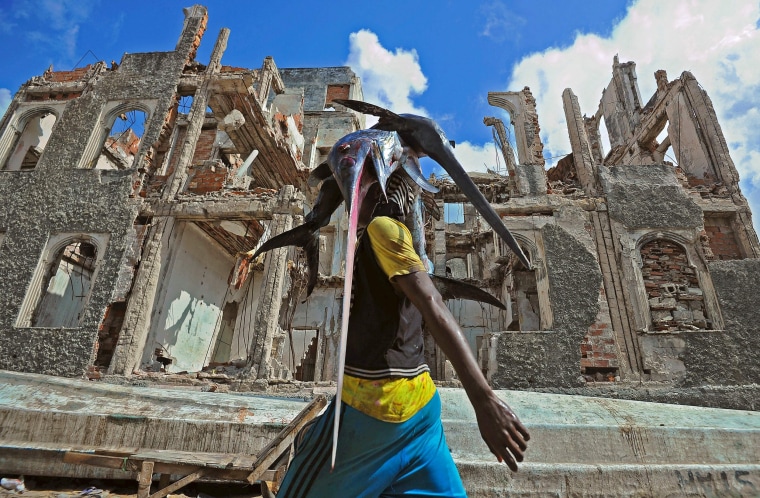
A fisherman carries a sailfish on his head to the fish market in Hamarweyne near the port of Mogadishu on Apr. 4, 2016.
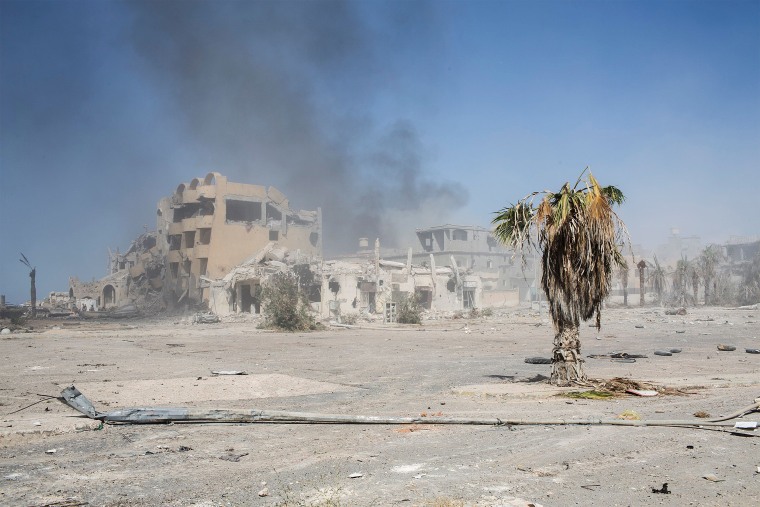
Both Libya and Tripoli itself are home to myriad armed groups with shifting and conflicting loyalties that have sought to fill the power vacuum created when long-time leader Muammar Gaddafi was killed in 2011.
In 2014, fighting between armed alliances backing opposing political factions resulted in rival governments being set up in the capital and the east.
Since March last year a third, U.N.-backed government has been trying to establish itself in Tripoli.
Above: Smoke rises from a destroyed neighborhood in Sirte as fighting continued between pro-Libyan government fighters and ISIS on Sept. 22, 2016.

A sniper from Misrata fires towards ISIS positions in Sirte on Sept. 21, 2016.
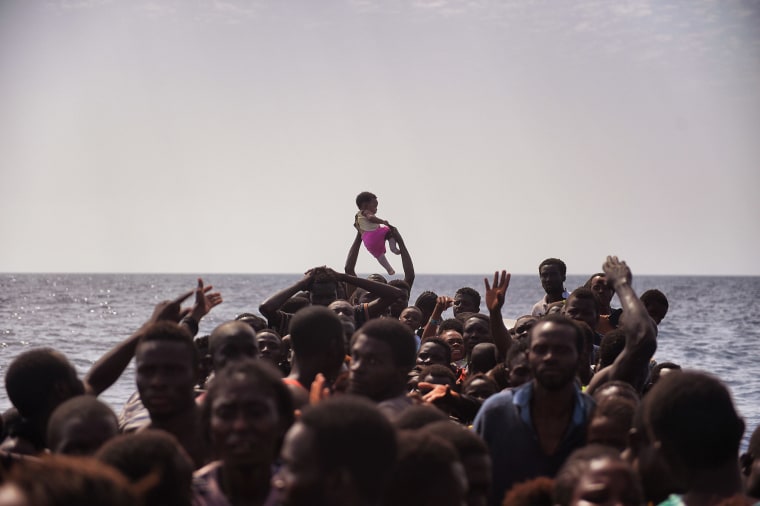
Migrants wait to be rescued by members of Proactiva Open Arms in the Mediterranean Sea, some 12 nautical miles north of Libya on Oct. 4, 2016.
The largest flow of modern African migration funnels through a single country — Libya.
Some arrive by choice, others by force. But Libya is the purgatory where most migrants prepare to face the deadliest stretch of the Mediterranean Sea.
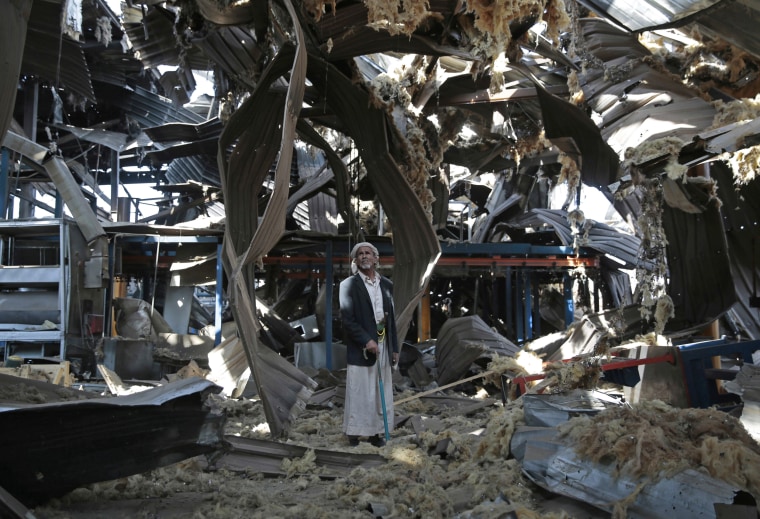
Yemen has been enmeshed in a civil war between Shiite Houthi rebels fighting the government of President Abed Rabbo Mansour Hadi that erupted in March 2015.
Al Qaeda has capitalized on the resultant chaos and has increased its territory in the country.
Above: An elderly man stands among the rubble of the Alsonidar Group's water pump and pipe factory after it was hit by Saudi-led airstrikes in Sanaa on Sept. 22, 2016.
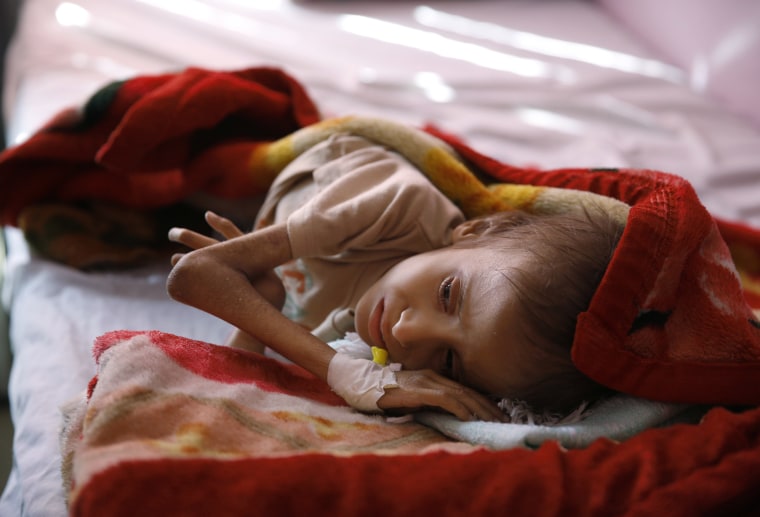
A malnourished child waits to receive treatment at a therapeutic feeding center in a hospital in Sanaa on Jan. 24, 2016.
Hunger among Yemen's children has reached an "all time high", with nearly 2.2 million in need of urgent care, the U.N. children's agency UNICEF said in December.
At least 462,000 children suffer from severe acute malnutrition - meaning they are extremely underweight for their height - a drastic increase of almost 200 percent since 2014, UNICEF said.
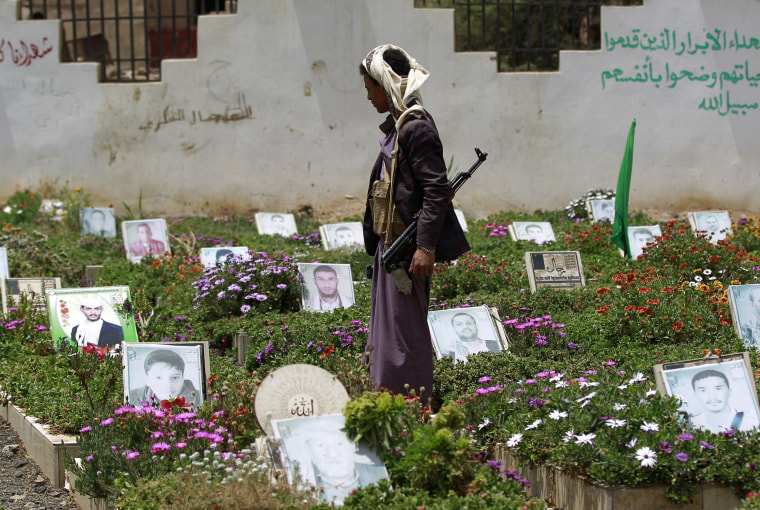
A Yemeni Houthi supporter visits a cemetery in Sanaa on Mar. 25, 2016.
The UN says civilians account for more than half of the people killed in the conflict.
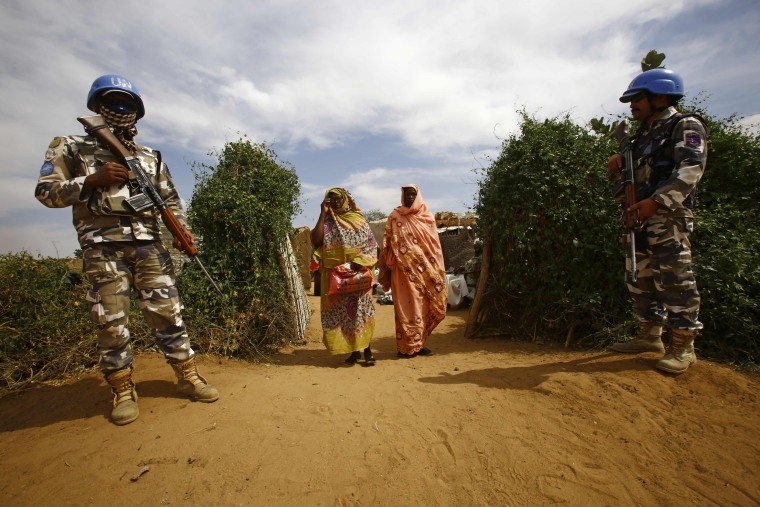
The U.S. has labelled Sudan a state sponsor of terrorism and enforces sanctions tied to Khartoum's role in the conflict in Darfur, where the United Nations says up to 300,000 people have been killed and millions displaced since 2003.
Above: Women walk past U.N. peacekeepers standing guard at the Attash refugee camp in Nyala in south Darfur on Jan. 9, 2017.
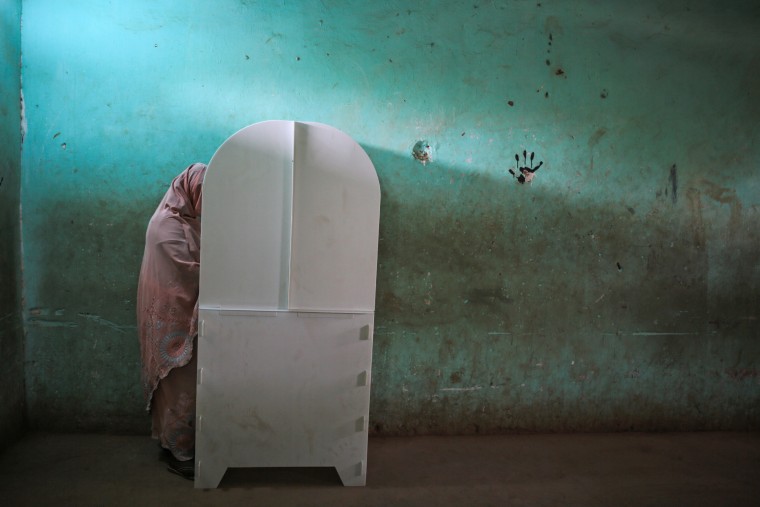
A Sudanese woman fills her ballot at a polling station on the first day of Sudan's presidential and legislative elections, in Izba, an impoverished neighborhood on the outskirts of Khartoum, on Apr. 13, 2015.
We need your support today
Independent journalism is more important than ever. Vox is here to explain this unprecedented election cycle and help you understand the larger stakes. We will break down where the candidates stand on major issues, from economic policy to immigration, foreign policy, criminal justice, and abortion. We’ll answer your biggest questions, and we’ll explain what matters — and why. This timely and essential task, however, is expensive to produce.
We rely on readers like you to fund our journalism. Will you support our work and become a Vox Member today?
Biden is ending Trump’s travel ban
It’s the beginning of the end for Trump’s immigration policies.
by Nicole Narea

On his first day in office, President Joe Biden is beginning the immense task of dismantling former President Donald Trump’s nativist legacy on immigration, issuing an executive order to end Trump’s controversial travel ban on noncitizens from 13 countries.
The policy, colloquially known as the “Muslim ban,” first went into effect in January 2017 and became one of Trump’s signature immigration policies. The ban has slowed or altogether halted legal immigration from certain countries that the former administration deemed to be security threats, keeping families apart and even stymieing refugee resettlement.
The travel ban was Trump’s first major action on immigration policy, setting the tone for the chaotic four years that followed for immigrants while galvanizing public opposition.
- Biden’s flurry of first-day executive actions, explained
When the ban was announced, it resulted in mass protests in airports across the US where people from the affected countries, which were initially limited to those with majority-Muslim populations, were held for questioning for hours.
This led immigrant advocates to call it a discriminatory “Muslim ban,” citing Trump’s campaign promise to establish a “total and complete shutdown of Muslims entering the United States.” Democrats in Congress, who for years had expressed conflicting positions on immigration policy , coalesced in opposition to the policy, using it to present a united front in condemnation of the xenophobia it represented.
The ban was amended several times in the face of numerous court challenges arguing that Trump did not have the legal authority to issue it and that it unlawfully discriminated against Muslims. The third version of the ban, ultimately upheld by the Supreme Court, barred citizens of seven countries — Iran, Libya, Somalia, Syria, Yemen, Venezuela, and North Korea — from obtaining any kind of visas, largely preventing them from entering the US. (Chad was taken off the list of countries subject to the ban in April 2019 after it met the Trump administration’s demands to share information with US authorities that could aid in efforts to vet foreigners.)
Trump expanded the ban last February to include additional restrictions on citizens of six more countries: Myanmar, Eritrea, Kyrgyzstan, Nigeria, Sudan, and Tanzania. While they could still visit the US, citizens of these countries were, for the most part, barred from settling in the US permanently.
Ending the ban was one of Biden’s topline campaign promises on immigration policy — and he is about to deliver. But this executive order only marks the beginning of a project to erase Trump’s influence on the immigration system, which was primarily concerned with keeping people out through a vast network of executive orders, policy memos, and regulatory changes.
The travel ban represented a sweeping curb on legal immigration
The human cost of the travel ban has been devastating. Not only has the policy torn families apart, but it has also contributed to crises including doctor shortages in rural America and a dramatic drop in enrollment among foreign students from affected countries.
More than 41,000 people have been denied visas due to the ban. Citizens of any of the banned countries could qualify for a waiver that would grant them entry to the US if, for example, they needed urgent medical care or were trying to reunite with their immediate family in the US. But those waivers proved exceedingly difficult to obtain .
Data from the State Department suggests that fewer people have been applying for visas since the ban was enacted: In fiscal year 2019, immigration authorities granted about 39,000 visas to noncitizens from the original seven countries covered by the ban as compared to almost 338,000 just three years prior — about an 88 percent drop. Iran and Venezuela saw the biggest declines.
There was also a significant decline in the number of visas granted to citizens from the six countries subject to the expanded ban in 2020; but it’s hard to say how much of that decrease can be attributed to separate travel restrictions implemented on account of the Covid-19 pandemic. (Biden has left open the possibility of keeping those restrictions in place.)
People affected by the travel ban who have relatives in the US have had to endure a form of family separation for the past four years. Biden’s decision to rescind the ban will “lift a persistent cloud of hopelessness and uncertainty” for families in the US and abroad, Farhana Khera, executive director of the nonprofit Muslim Advocates, said in a statement.
One Syrian American man, Ramez Alghazzouli, waited three years before his wife, Asmaa Khadem Al Arbaiin, could join him in the US due to the ban. Her visa was only granted after the publication of an article in HuffPost detailing his struggle. “This can destroy a human being. I’m not an emotional guy but it distracted and destroyed me,” Alghazzouli told Time .
National security experts have argued that the suffering of those like Alghazzouli was largely in vain: The travel ban has not made America safer, despite the Trump administration’s arguments to the contrary.
The Trump administration claimed that all the affected countries pose threats to US national security based on the findings of multiple government agencies. But the agencies’ findings were never made public, meaning the nature of those threats remains unclear. The administration broadly cited terrorist activity, failure of the countries to properly document their own travelers, and insufficient efforts to cooperate and share information with US authorities as justification for the ban.
But dozens of former intelligence officials have opposed the ban. Elizabeth Neumann, a former assistant secretary for counterterrorism and threat prevention at the Homeland Security Department under the Trump administration, said in a press call earlier this month that the ban has hurt America’s relationships with foreign governments, which are critical to US national security interests. The US government should have worked with foreign governments to improve their own security procedures and information-sharing structures, without punishing them for not already being up to standard, she said.
Neumann and others have also said that the ban, which overemphasized the threat of Islamist terrorism, detracted from national security officials’ ability to respond to the rising threat of domestic terrorism — including the violent insurrection at the US Capitol earlier this month.
“Whatever window dressing the administration sought to put on the travel ban, it’s seen around the world as what it is: an anti-Muslim directive,” Ryan Crocker, a former US ambassador in the Middle East, said in the press call. “And that has damaged us greatly.”
How Biden could make amends for the travel ban
While Wednesday’s news may come as a relief to those affected by the travel ban, it’s clear that ending the ban is only the beginning of the process of dismantling one of Trump’s cruelest immigration policies.
Although legal immigrants now have a greater chance of being approved for a visa, the Trump administration has imposed other barriers, from implementing “extreme vetting” of their applications to expanding biometrics requirements .
“People harmed by the ban will still need to navigate a bureaucratic minefield made even more treacherous by the Trump administration,” Khera said. “The Biden administration must take sweeping administrative action to clear away these hurdles and reunite families as soon as humanly possible.”
Immigrant advocates are calling on the Biden administration to increase refugee admissions from affected countries. Trump slashed the overall refugee admissions cap to 15,000 this year and all but suspended refugee admissions from Yemen, Somalia, and Syria on the basis of perceived terrorism risks. Biden has vowed to raise the refugee cap to 125,000 but hasn’t identified whether people of certain nationalities will be prioritized for admission.
Advocates are also pushing Congress to prioritize passing the NO BAN Act, which cleared the House of Representatives in July and would prevent any future administration from implementing a similar ban. The bill would amend the current law to require that any travel ban be temporary, based on credible evidence, subject to congressional oversight, and created only in response to specific actions foreign entities have taken to threaten the US. The bill also states that a ban must advance a compelling government interest in the least restrictive way possible.
Tom Jawetz, vice president of immigration policy at the Center for American Progress think tank, told Vox that legislation like the NO BAN Act is necessary because Biden’s decision to repeal the travel ban will not itself “stop a future administration from trying to shape an immigration system in his or her own anti-immigrant, racist image.”
Biden has incorporated the NO BAN Act in a sweeping immigration reform proposal he will send to Congress on Wednesday. But it remains unclear whether the administration — facing a pandemic and Trump’s impeachment trial — will have the bandwidth to push such legislation through Congress during the president’s first 100 days.
- Donald Trump
- Immigration
- Trump Administration
More in this stream

Most Popular
- The impact of the Supreme Court’s reversal of affirmative action, explained in one chart
- 3 winners and 2 losers from the Harris-Trump debate
- Sign up for Vox’s daily newsletter
- Donald Trump lost the debate because he’s too online
- It happened there: how democracy died in Hungary
Today, Explained
Understand the world with a daily explainer plus the most compelling stories of the day.
This is the title for the native ad
More in Politics

Preliminary data shows a negative impact on Black enrollment at some universities.

Back in 2016, the alt-right tried to normalize joyful bigotry. It worked.

US Steel is a throwback to when American steel and American unions were powerful. Now it might be sold.

Can an American ally be held accountable if it kills a US citizen?

Harris says US troops aren’t fighting in any “war zones.” What about Iraq, Syria, and the Red Sea?

The GOP nominee spoke to swing voters as though they were his Truth Social followers.
- Share full article
Advertisement
Supported by
Trump Travel Ban: How It Affects the Countries

By Rick Gladstone
- June 26, 2018
To President Trump’s supporters, the Supreme Court decision upholding his travel ban from seven countries — five with Muslim majorities — was an affirmation by the highest court in the land of his right to secure America’s borders and protect it from terrorism.
To opponents, the ruling validated an anti-Muslim agenda that betrayed American ideals, subverted the Constitution and upended the hopes of thousands of families separated by war and deprivation.
Here are three outcomes of the decision, which bans or severely restricts entry into the United States by people from Iran, Libya, North Korea, Somalia, Syria, Venezuela and Yemen.
There Is No Escape to America
The ruling sends a blunt message of rejection to visa seekers from some of the most destitute and dysfunctional countries. Immigration and civil-rights lawyers fear that it slams the door on many desperate people from the Muslim-majority countries that were affected, particularly those with relatives in the United States, who saw the Supreme Court as their last hope.
The timing of the ruling, as European Union countries are toughening policies toward refugees and asylum seekers, reinforced an atmosphere of a Western backlash to migrants, even as the global population of forcibly displaced people grows.
Three of the Muslim-majority countries affected by Mr. Trump’s order — Libya, Yemen and Syria — have known only war for years. A fourth, Somalia, has suffered through varying degrees of mayhem for decades. While antiterrorism experts consider the countries to be breeding grounds for violent extremism, the Supreme Court’s ruling will do nothing to hasten the end of the underlying conflicts there.
Although Mr. Trump’s executive order allows for granting exceptions on a case-by-case basis, lawyers said they had seen little or no evidence of such a process. Hundreds of Yemeni families with American relatives, for example, who have fled to Djibouti, a tiny country in the Horn of Africa, to file waiver applications for visas because the United States Embassy in Yemen is closed, have been summarily denied waivers and remain stranded there.
“All of them were hanging their hopes on the Supreme Court decision,” said Diala Shamas, a staff lawyer for the Center for Constitutional Rights, a New York-based advocacy group that sent investigators to Djibouti and produced a report with the Rule of Law Clinic at Yale Law School about the stranded families.
“All of those people who were holding their breath are now facing the difficult choice of either permanent separation from their families or returning to Yemen,” she said.
Mohamud Noor, a Somali-American activist in the Minneapolis area, home to one of the largest Somali immigrant communities, said the Supreme Court decision was devastating to many who wanted relatives in their homeland to legally join them.
“I think we were expecting the Supreme Court would stand on moral grounds,” Mr. Noor said. “We live in America. This is a land of immigrants.”
Iranians Could Be Most Affected
The Muslim-majority country facing the most disruption is Iran, which historically has led the others in nonimmigrant visas to the United States, despite the estrangement in relations since the 1979 Islamic Revolution.
By some estimates one million American citizens of Iranian descent live in the United States, and many have traveled to Iran for family visits. But it is difficult to see how their Iran-based relatives can visit them.
Fear first rippled through the Iranian-American community with Mr. Trump’s initial iteration of a travel ban 18 months ago , which caused chaos in its disorganized rollout and was blocked by the courts.
But the angst has returned with the latest iteration, especially now that it has been validated by the Supreme Court, said Jamal Abdi, vice president of policy at the National Iranian American Council, a Washington-based advocacy group.
“Iranians cannot travel here unless they get a waiver. The waiver process is unpredictable, with no explanation of how it will be implemented,” he said. “So there is extreme uncertainty. I think a lot of people are living with this.”
The impact is likely to further anger Iran’s hard-line opponents to Mr. Trump as he has moved to isolate the country. Iran already is feeling the ill effects of Mr. Trump’s decision last month to withdraw the United States from the 2015 nuclear agreement and reimpose economic sanctions, which penalize businesses in other countries for doing business with Iran.
The Supreme Court decision came the same day the State Department said it expected all countries to cut their imports of Iranian oil to zero under the reimposed sanctions that take effect in November.
Least Hurt: Venezuela and North Korea
The practical effects on the two non-Muslim majority nations on Mr. Trump’s travel ban — Venezuela and North Korea — are minimal, lending weight to critics who said their inclusion was meant to mask what was essentially a ban that affected Muslims.
The restrictions on Venezuelans apply only to a narrow category of government officials deemed responsible for failing to cooperate with the Department of Homeland Security in identifying visa seekers who are security risks.
While the restrictions on North Koreans apply to all, there are hardly any who are allowed by their government to come to the United States.
“Most people have forgotten that North Korea was added to the list of countries subject to the ban, mostly as a way of making it look less like an anti-Muslim measure,” said Evans J.R. Revere, a former State Department diplomat who is an expert on North Korea.
While North Korea’s leader, Kim Jong-un, may regard North Korea’s inclusion on the travel ban as an unfriendly act, he is far more concerned with all of the other sanctions imposed on North Korea because of the country’s nuclear and ballistic missile development.
Mr. Trump, who met with Mr. Kim at a groundbreaking summit meeting in Singapore on June 12, has said the North Korean leader is committed to denuclearization, but large questions remain over how, when or even whether it will happen.
Sung-Yoon Lee, a professor of Korean studies at Tufts University, said “the inclusion of North Korea is likely to be reversed by the administration — that is, used as a chip in further advancing the illusion of rapprochement.”
Our Coverage of U.S. Immigration
A Migrant Family’s Struggles: Margarita Solito and her family fled violence and poverty in El Salvador, hoping to build a better life in San Francisco. The city often wasn’t what they thought it would be .
Home-Buying Assistance: Gov. Gavin Newsom of California rejected a Democratic proposal that would have extended first-time home-buyer loans to some undocumented immigrants. Republicans had widely criticized the bill.
When One Partner Is Deported: American citizens whose spouses have been deported face wrenching decisions on what is best for their future, especially when they have children.
Asylum Restrictions: The Biden administration is considering actions that would make the president’s tough but temporary asylum restrictions almost impossible to lift , essentially turning what had been a short-term fix into a central feature of the asylum system in America.
Immigration Divides a Town: Jobs attracted thousands of Haitians to Springfield, Ohio, and employers were ecstatic. But a fatal bus crash touched off resentment , and JD Vance entered the fray.

Terrorism and Trump’s Travel Ban
By Eugene Kiely
Posted on February 24, 2017
Stephen Miller, a senior White House policy adviser, claimed that 72 people from the seven countries covered by President Donald Trump’s 90-day travel ban “have been implicated in terroristic activity in the United States” since the 9/11 attacks. That’s a gross exaggeration.
Miller cited an analysis by the Center for Immigration Studies that covered alleged terror cases from Sept. 12, 2001, through Dec. 31, 2014. We reviewed the convictions of all 72 people included on the list, and here is what we found:
- Most — 44 of the 72 people — were not convicted on terrorism charges. Many were swept up in terrorism investigations, but investigators failed to provide evidence of terrorism-related crimes. Prosecutors instead filed fraud, immigration and other lesser charges. One of the 44 had his conviction overturned on appeal.
- More than a third — 28 of the 72 — were convicted of terrorism crimes or pleaded guilty to terrorism-related activity. The vast majority of these people were convicted of helping to finance terrorism outside the U.S. Only three of the 28 were convicted of plotting acts of terrorism on U.S. soil, and two of them were sting operations.
- Four of the 72 were arrested in foreign countries and extradited to the United States for prosecution. Three of the four were convicted on terrorism charges. None of the four would have been blocked by Trump’s travel ban, since they were not attempting to enter the U.S. In fact, three of the four, including a Dutch citizen, were arrested in countries (Spain, Romania and the Netherlands) that were not covered by the travel ban.
None of the 72 people was responsible for any terrorist-related deaths in the U.S. — even though roughly 1 million citizens of the seven countries came to the U.S. during this time as refugees, immigrants or on nonimmigrant visas, according to our review of State Department data.
Defending Trump’s Travel Ban
Miller appeared on several Sunday talk shows on Feb. 12 and discussed, among other things, the president’s executive order — Protecting the Nation from Foreign Terrorist Entry into the United States . The order imposes a 90-day travel ban on the citizens of seven predominately Muslim countries (Iraq, Syria, Iran, Sudan, Libya, Somalia and Yemen). It also indefinitely prohibits Syrian refugees from entering the U.S., and suspends the refugee program for citizens of all other countries for 120 days.
U.S. District Judge James L. Robart on Feb. 3 issued a temporary restraining order that blocked portions of Trump’s order from taking effect, pending his full consideration of a lawsuit filed by the states of Washington and Minnesota seeking to permanently block Trump’s order. The 9th Circuit Court of Appeals in San Francisco on Feb. 9 unanimously denied the Trump administration’s emergency motion to lift Robart’s temporary order.
“The Government has pointed to no evidence that any alien from any of the countries named in the Order has perpetrated a terrorist attack in the United States,” the 9th Circuit Court of Appeals said.
As a result of the court decisions, refugees approved for resettlement in the U.S. and visa holders of the seven countries can travel to the U.S., pending further action by the administration or the courts.
In defense of the temporary travel ban, top White House officials have cited terrorism attacks that never happened. Kellyanne Conway, the counselor to the president, spoke of the “ Bowling Green massacre ” and White House spokesman Sean Spicer repeatedly listed “Atlanta” among the sites of U.S. terror attacks. (We did not write about those incidents, because both acknowledged their mistakes. We try not to play gotcha here at FactCheck.org.)
On NBC’s “ Meet the Press ,” Miller also defended the president’s travel ban, and criticized the court decisions. Host Chuck Todd asked Miller why the administration’s travel ban does not include citizens from countries that have a history of committing terrorism in the U.S., such as Saudi Arabia.
Miller, Feb. 12: First of all, 72 individuals according to the Center for Immigration Studies have been implicated in terroristic activity in the United States who hail from those seven nations.
Miller made a similar statement on ABC’s “ This Week ” that same day.
Miller, Feb. 12: We know there’s at least several dozen, perhaps many more than that, cases of terrorism from these countries that have happened in the United States in terms of terroristic plots, terroristic activity, material support for terrorism, supporting terrorism overseas — all different kinds of terroristic activity that’s been interdicted in the United States tracing back to these seven countries.
The Center for Immigration Studies, an advocacy group for low immigration , posted a blog item on Feb. 11 that said “72 individuals from the seven countries covered in President Trump’s vetting executive order have been convicted in terror cases since the 9/11 attacks.” CIS extracted the 72 names from a larger list of foreign-born suspected terrorists compiled by the Senate Judiciary Committee’s subcommittee on immigration.
We reviewed the CIS list and found that not all 72 individuals from the seven countries covered by Trump’s travel ban were convicted of terrorism charges.
44 Convictions — None for Terrorism
Most of the 72 individuals referenced by Miller were not convicted on terrorism charges. Many of them were caught up in terrorism investigations in the days following the Sept. 11, 2001, attacks, but were either never charged or not convicted of terrorism.
For example, CIS listed 19 Iraqis convicted in terror cases. But we found that only three Iraqis were convicted on terrorism charges. Most — 11 of the 19 — were part of a terrorism investigation in Pittsburgh that ended up as a simple fraud case that had nothing to do with terrorism.
In the Pittsburgh case, Kamel Albred, Haider Alshomary, Haider Al-Tamimi, Ali Alubeidy, Alawi Al-Baraa, Mustafa Al-Aboody, Mohammed Alibrahimi (a cousin of Ali Alubeidy), Fadhil Al-Khaledy, Hatef Al-Atabi, Wathek Al-Atabi and Elmeliani Benmoumen were among 20 people arrested in the days following the 9/11 attacks on charges they illegally obtained commercial driver’s licenses and hazmat transportation permits, according to the Pittsburgh Post-Gazette . Federal prosecutors feared that the men obtained the licenses in order to transport hazardous materials across the country to carry out terrorist attacks, the Post-Gazette wrote .
But the terrorism investigation fizzled.
When one of the defendants, Alawi Al-Baraa, pleaded guilty to illegally obtaining a hazmat license by bribing a state official, the Post-Gazette wrote, U.S. District Judge Robert Cindrich “took the unusual step” at the hearing of asking the federal prosecutor to make clear that Al-Baraa’s case had nothing to do with terrorism.
Post-Gazette , Dec. 14, 2001: “We have attempted through the FBI’s efforts to establish any possible connections between Mr. Al-Baraa’s activities and the events of Sept. 11,” said Assistant U.S. Attorney Bruce Teitelbaum. “We have been unable to establish any link.” Teitelbaum said there is no reason to believe Al-Baraa is anything but a truck driver who paid bribe money to get a new hazmat certification without taking the required test.
Nearly four years later, the Washington Post wrote a story about the Pittsburgh case — “ The Terrorism Case That Wasn’t — and Still Is ” — that quoted Cindrich as saying that he would “not continue to characterize this as a successful prosecution of a terrorism case, because it was not.”
Similarly, CIS identified 19 Yemeni citizens on its list of 72 individuals “convicted in terror cases,” but we found only four who were convicted on terrorism charges. Most of them — 10 — were initially suspected of funneling money to terrorists through illegal money transfers, but the investigations failed to support terrorism charges.
For example, federal authorities grew suspicious of a check-cashing business in California and set up a sting operation that resulted in the March 2007 arrests of three Yemen-born men, Yehia Ali Ahmed Alomari, Mohamed Al Huraibi and Saleh Mohamed Taher Saeed. The men agreed to arrange illegal overseas transfers of more than $100,000 for an undercover agent who allegedly “told the men that some of the money would go to Hezbollah, an organization linked to terrorism,” according to the Rochester Democrat and Chronicle .
However, the paper wrote, “U.S. District Judge Charles Siragusa did not allow mention of Hezbollah during the trial because the criminal charges the men faced had no connection to terrorism.” Ultimately, the three each pleaded guilty to operating an illegal money-transmitting business — an outcome “authorities contended” was “fair, given the government’s evidence,” the Rochester Democrat and Chronicle wrote. The paper said that one of the jurors told the men, “I hope you go and have a good life.”
Like the Pittsburgh case we mentioned earlier, several of the terrorist investigations were launched in the days following the 9/11 attacks but terrorism charges failed to materialize:
- Mustafa Kilfat and his father were stopped while driving in New Jersey because they were “driving a red Pontiac — a car law enforcement officials briefly believed was connected to the attacks” on Sept. 11, 2001, according to the New York Daily News . The two men had no connection to the 9/11 attacks, but Kilfat — a Syrian citizen — was convicted on one count of visa fraud.
- Nageeb Abdul Jabar Mohamed Al-Hadi was arrested in Toronto in the hours immediately after the Sept. 11, 2001, terrorist attacks. He was bound for Chicago using a false name, carrying three Yemeni passports and two Lufthansa uniforms, according to the Chicago Tribune . “A prosecutor in the case said Al-Hadi provided the false information because he didn’t think he would be allowed to re-enter the United States, after abandoning the legal status that he had obtained here in the 1980s through a sham marriage,” the paper wrote. Al-Hadi was convicted on one count of visa fraud.
- Mohamed Abdi, a Somalian living in Virginia, was arrested in the days soon after the 9/11 attacks because authorities found his name and phone number written on a Washington street map inside a 1988 Toyota registered to Nawaf al Hazmi, one of the 9/11 hijackers who crashed into the Pentagon, according to CNN and the Chicago Tribune . But, as the Washington Post later reported , “authorities were unable to find any connection to terrorism.” Abdi pleaded guilty to forging rental subsidy checks.
- Mohammed Refai became a suspect shortly after the 9/11 attacks when “federal investigators in Arkansas found documents that appeared to connect one of the terrorist hijackers, Saeed Alghamdi, with an apartment complex in Akron, Ohio,” the New York Times wrote . Refai lived in the complex. “According to newspaper accounts, investigators apparently have decided that the documents from Arkansas involved a case of mistaken identity,” the Times wrote.
Other examples of terror investigations that did not result in terrorism convictions, but were among the 72 cited by Miller:
- Mohamed Hussein, a Somalian businessman living in Massachusetts, was “suspected of diverting money to the al-Qaeda network,” according to the Agence France Presse, but was convicted on two counts of illegal money transfers. Prosecutors presented no evidence linking Hussein to terrorists. U.S. District Judge Robert E. Keeton sentenced Hussein to 18 months, rather than the five years sought by prosecutors. “You’re trying to ask me to sentence him as a terrorist,” Keeton told a prosecutor . “It shocks my conscience that I would even be asked to do that.” (Note: Hussein’s name was misspelled on the CIS list as “Mohammed Husssein.”)
- Pirouz Sedaghaty, who goes by the name of Pete Seda, was convicted in 2010 of two felonies related to his charity, the Al-Haramain Islamic Foundation. Federal prosecutors accused Seda of using his organization “to send nearly $150,000 to support religious extremist militants in Chechnya,” according to the Justice Department . But he faced no terrorism charges and his conviction was overturned on appeal by the 9th U.S. Circuit Court of Appeals in San Francisco. “This is a tax fraud case that was transformed into a trial on terrorism,” Circuit Judge M. Margaret McKeown wrote in the court opinion.
Terrorism Convictions and Pleas
Of course, some citizens of the seven countries covered by Trump’s ban were convicted on terrorism charges. In all, there were 28 individuals who were either convicted on terrorism charges (25) or admitted to terrorism activity (three) in pleading guilty to lesser charges.
Of those 28, however, three arrests occurred abroad, and the suspects were extradited to the United States. None of them were trying to enter the U.S., so they would not have been blocked by Trump’s travel ban. Like Osama bin Laden, they were plotting attacks from other countries.
For example, Syrian arms dealer Monzer Al Kassar was extradited from Spain and later convicted on charges of conspiring to sell millions of dollars worth of high-powered weapons to the Revolutionary Armed Forces of Colombia, or FARC, to be used to kill Americans in Colombia, according to the New York Times .
Al Kassar was convicted of, among other things, providing material support to terrorists. That was true for most of the terrorism convictions, and many of them were Somalian citizens living in the U.S. In all, there were 14 Somalians convicted of helping to finance terrorism abroad, typically for al-Shabaab — a terrorist group operating in East Africa whose leaders are affiliated with al Qaeda, according to the National Counterterrorism Center .
There were only three cases during this time in which foreign-born residents of the seven countries on Trump’s temporary travel ban attempted to carry out a terrorist attack in the U.S. — two of which were not real attacks, but rather government sting operations:
- Mohamed Osman Mohamud, a naturalized U.S. citizen from Somalia who lived in Oregon, was charged in an undercover sting operation with attempting to set off a fake bomb supplied by undercover FBI agents at a Christmas tree-lighting ceremony in Portland. He was sentenced in October 2014 to 30 years in prison.
- Yassin Aref, a Kurdish refugee from Iraq, was convicted in a counterterrorism sting operation in 2006. According to the New York Times and the Albany Times Union , an undercover federal agent told Mohammed M. Hossain, Aref’s co-defendant, that he planned to assassinate the Pakistani ambassador to the U.S. in New York City and then sell the weapon for $50,000. The undercover agent offered to give Hossain a $50,000 loan for improvements to his pizza shop. “According to testimony, Mr. Hossain asked Mr. Aref to attend another meeting with the informant to act, by Muslim custom, as a witness to the loan,” the New York Times wrote.
- Mansour J. Arbabsiar, an Iranian American living in Texas, was convicted on charges of “plotting to hire assassins from a Mexican drug cartel to murder Saudi Arabia’s ambassador to the United States,” according to the New York Times . He pleaded guilty to “conspiracy to commit an act of terrorism transcending national boundaries and two counts related to murder-for-hire,” the Times said.
To sum up, we found 28, or more than a third, of the 72 people cited by Miller were convicted on terrorism charges. We found that 25 of the 28 people were in the U.S., when they were arrested. Only three of 25 were implicated in plotting a terrorist attack on U.S. soil, and only one of those was aimed at U.S. citizens on U.S. soil — a government sting operation, not an actual attack.
None of the U.S. residents from Iraq, Syria, Iran, Sudan, Libya, Somalia and Yemen were responsible for any attacks on U.S. soil that resulted in a loss of life. At the same time, roughly 956,000 citizens of those countries entered the U.S. as refugees and visa holders, according to State Department data.
A total of 258,508 refugees from the seven countries resettled in the U.S. from Sept. 12, 2001, to Dec. 31, 2014. Another 697,113 others obtained immigration and nonimmigration visas in fiscal years 2002 through 2014, which covers Oct. 1, 2001, to Sept. 30, 2014.
Here is the breakdown, by country:
Editor’s Note: We obtained refugee data from the State Department’s Refugee Processing Center , and the visa holder data from the State Department’s Bureau of Consular Affairs . Our analysis of the Center for Immigration Studies list of 72 “terror cases” can be found in a spreadsheet that you can download here . FactCheck.org added the last three columns to the spreadsheet, which otherwise remains as it appears on the CIS website. FactCheck.org Fellows Sydney Schaedel, Ilana Nathans and Jenna Wang assisted in the research for this article.


IMAGES
VIDEO
COMMENTS
President Donald Trump has signed an executive order that banned travel into the United States for citizens from these seven countries for 90 days: Iran, Iraq, Libya, Somalia, Sudan, Syria and Yemen.
The latest iteration of the ban includes restrictions against five majority-Muslim nations — Iran, Libya, Somalia, Syria and Yemen. North Korea and Venezuela are also on the list. Three other ...
The Trump travel ban was a series of executive actions taken by U.S. President Donald Trump that restricted entry into the United States by certain foreign nationals, beginning with Executive Order 13769, issued on January 27, 2017. [1][2] It was labeled as a " Muslim ban " by Trump, his aides, [3][4] as well as his critics, [5][6] and became ...
The Biden administration announced plans on Friday to ban travel to the United States from South Africa and seven other countries, just hours after a new coronavirus variant was deemed a highly ...
The seven nations identified in Donald Trump's travel ban were "identified by the Obama administration as the seven most dangerous countries in the world in regard to harboring terrorists."
The travel ban: The Supreme Court issued a ruling upholding Trump's travel ban. Which countries are affected: It restricts entry from seven countries to varying degrees: Iran, North Korea, Syria ...
The United States will restrict travel for non-U.S. citizens from South Africa and seven other countries starting Monday as a new Covid variant emerges. President Joe Biden was briefed Friday by ...
President Biden will restrict travel from South Africa and seven other African countries to try to contain a troubling new variant of the coronavirus, senior administration officials said on ...
Travel ban:US to restrict travel from South Africa, seven other countries due to new COVID-19 variant omicron Follow USA TODAY reporter Bailey Schulz on Twitter: @bailey_schulz . Featured Weekly Ad
Executive Order 13780, titled Protecting the Nation from Foreign Terrorist Entry into the United States, was an executive order signed by United States President Donald Trump on March 6, 2017. It placed a 90-day restriction on entry to the U.S. by nationals of Iran, Libya, Somalia, Sudan, Syria and Yemen, and barred entry for all refugees who did not possess either a visa or valid travel ...
Increased hate crimes, violence, sexual assault and other forms of criminality, have countries warning their citizens about travel to the United States. Travel Noire revealed why New Zealand ...
Politics Apr 25, 2018 4:57 PM EDT. The Supreme Court heard arguments Wednesday over a version of President Donald Trump's travel ban, which bars people from seven countries, five of them ...
So far in 2024, the State Department made changes to the existing Level 4 advisories for Myanmar, Iran and Gaza, and moved Niger and Lebanon off of the Level 4 list. Places With a Level 4 Travel ...
The US Supreme Court has upheld a ban by President Donald Trump on travel to the US from seven countries: North Korea, Syria, Iran, Yemen, Libya, Somalia and Venezuela.. The ruling comes after ...
Level 1: Exercise Normal Precautions. July 26, 2023. Ghana Travel Advisory. Level 2: Exercise Increased Caution. November 20, 2023. Democratic Republic of the Congo Travel Advisory. Level 3: Reconsider Travel. July 9, 2024. Republic of the Congo Travel Advisory.
The everyday conflicts and difficulties faced by the people living in the seven countries subject to President Trump's travel ban. / Updated Jan. 31, 2017 / 12:15 PM UTC 20 PHOTOS
Related article What it's like in the 7 countries on Trump's travel ban list. Under the law, dual citizens of visa-waiver countries and Iran, Iraq, Sudan, or Syria could no longer travel to the U ...
Executive Order 13769, titled Protecting the Nation from Foreign Terrorist Entry into the United States, labeled the "Muslim ban" by Donald Trump and his supporters [1] [2] and critics alike, [3] [4] and commonly known as such, [5] or commonly referred to as the Muslim travel ban, Trump travel ban, the Trump Muslim travel ban, or the Trump Muslim Immigration Ban, was an executive order by ...
It brings in a suspension of the US Refugee Admissions Programme for 120 days. There is also an indefinite ban on Syrian refugees. And anyone arriving from seven Muslim-majority countries - Iraq ...
The State Department estimated that less than 60,000 visas from the seven countries had been revoked by the travel ban. A United Nations spokesman told the New York Times that about 2,000 refugees ...
The third version of the ban, ultimately upheld by the Supreme Court, barred citizens of seven countries — Iran, Libya, Somalia, Syria, Yemen, Venezuela, and North Korea — from obtaining any ...
June 26, 2018. To President Trump's supporters, the Supreme Court decision upholding his travel ban from seven countries — five with Muslim majorities — was an affirmation by the highest ...
Stephen Miller, a senior White House policy adviser, claimed that 72 people from the seven countries covered by President Trump's 90-day travel ban "have been implicated in terroristic activity in ...